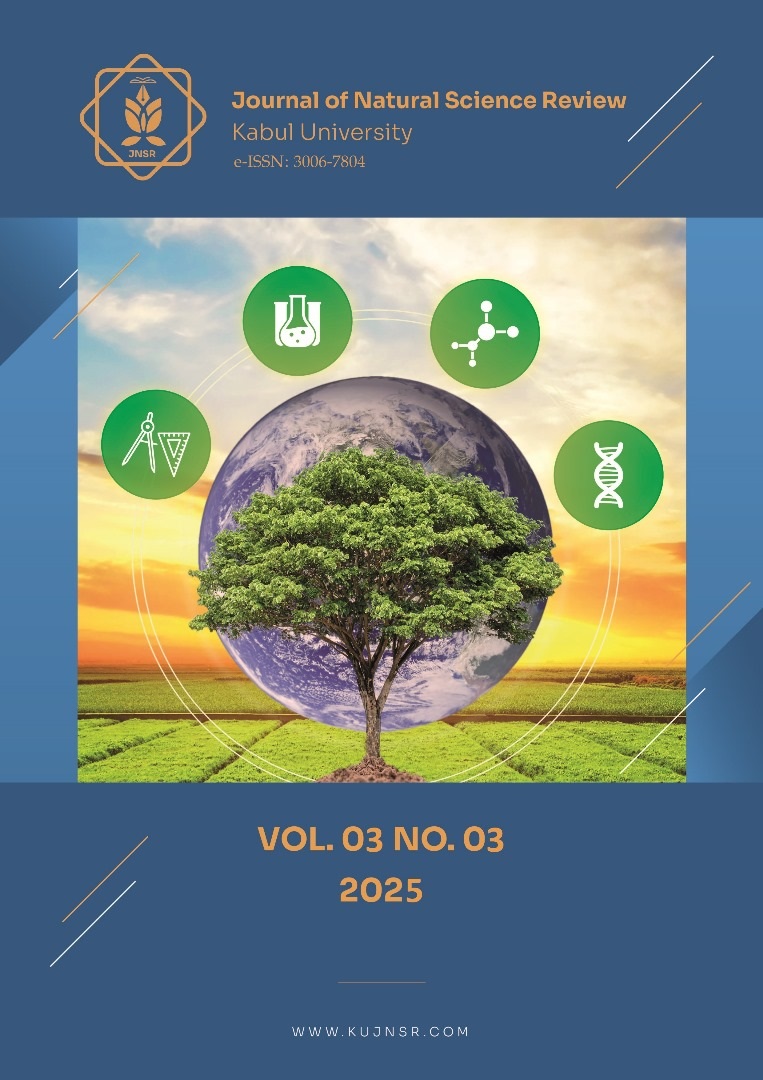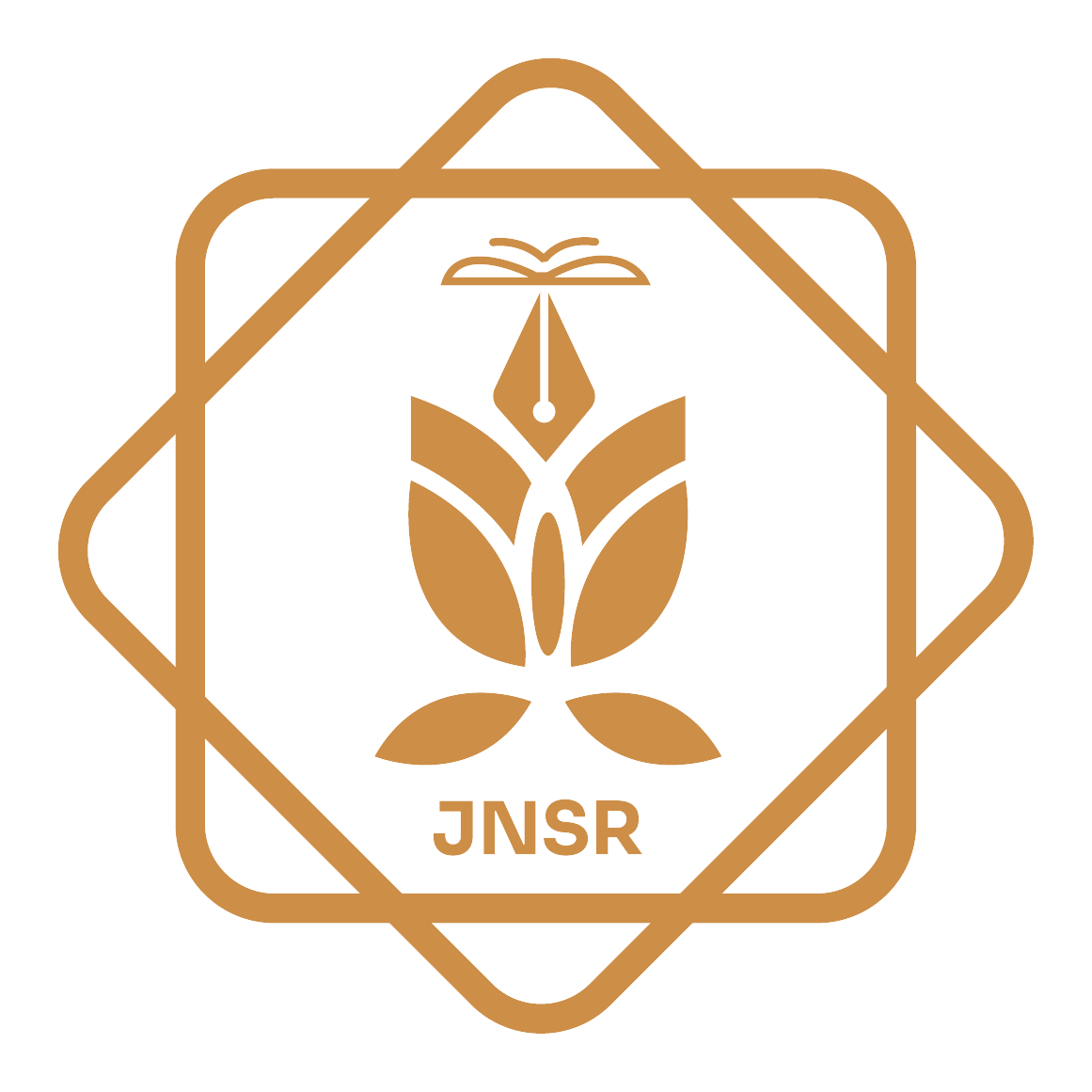Zinc Sulfate Monohydrate (ZnSO₄·H₂O) Toxicity in Medaka Embryos: Impacts of Water Type on Lethal Concentration
DOI:
https://doi.org/10.62810/jnsr.v3i3.268Keywords:
Zinc Sulfate, Javanese medaka, Acute toxicity, LC50, water chemistry, ecotoxicologyAbstract
Zinc sulfate (ZnSO₄) is widely used in industrial and agricultural applications; however, its release into the environment raises concerns about its potential toxicity to the aquatic ecosystem. This study assesses the acute toxicity of zinc sulfate monohydrate (ZnSO₄·H₂O) on Javanese medaka (Oryzias javanicus) embryos by examining mortality across three water types: pure water, deionized water, and dechlorinated tap water. Embryos were exposed to ZnSO₄ concentrations ranging from 0.1 to 10 mg/L for 96 hours, with mortality recorded at 24, 48, 72, and 96 hours. Mortality increased in a dose- and time-dependent manner, with no deaths observed in control groups. Toxicity was highest in pure water (LC₅₀ = 0.6676 mg/L), followed by dechlorinated tap water (LC₅₀ = 0.9583 mg/L), and lowest in deionized water (LC₅₀ = 1.021 mg/L). Water chemistry significantly influences ZnSO₄ toxicity, as ionic composition affects zinc uptake and its toxic effects. These results underscore the importance of site-specific water quality assessments in aquatic risk assessments. Further studies on long-term sublethal effects and metal bioaccumulation are needed to improve ecotoxicological risk assessments.
Downloads
References
Addai-Arhin, S., Shino, S., Uchida, M., Ishibashi, H., Arizono, K., & Tominaga, N. (2025). Toxicity of nickel, copper, and selenium in medaka embryos (oryzias latipes): A comparative study. The Journal of Toxicological Sciences, 50(1), 23–32. https://doi.org/10.2131/jts.50.23 DOI: https://doi.org/10.2131/jts.50.23
Amin, N., Vedi, F., Navid Wais, M., Zulkifli, S. Z., Azmai, M. N. A., & Ismail, A. (2024). Developmental Toxicity of Zinc Oxide Nanoparticles on the Early Life Stage of Java Medaka (Oryzias javanicus Bleeker, 1856). Pertanika Journal of Tropical Agricultural Science, 47(2). https://doi.org/10.47836/pjtas.47.2.16 DOI: https://doi.org/10.47836/pjtas.47.2.16
Amin, N., Zulkifli, S. Z., Azmai, M. N. A., & Ismail, A. (2021). Toxicity of Zinc Oxide Nanoparticles on the Embryo of Javanese Medaka (Oryzias javanicus Bleeker, 1854): A Comparative Study. Animals, 11(8), 2170. https://doi.org/10.3390/ani11082170 DOI: https://doi.org/10.3390/ani11082170
Brinkman, S. F., & Johnston, W. D. (2012). Acute Toxicity of Zinc to Several Aquatic Species Native to the Rocky Mountains. Archives of Environmental Contamination and Toxicology, 62(2), 272–281. https://doi.org/10.1007/s00244-011-9698-3 DOI: https://doi.org/10.1007/s00244-011-9698-3
DeForest, D. K., & Genderen, E. J. V. (2012). Application of U.S. EPA guidelines in a bioavailability-based assessment of ambient water quality criteria for zinc in freshwater. Environmental Toxicology and Chemistry, 31(6), 1264–1272. https://doi.org/10.1002/etc.1810 DOI: https://doi.org/10.1002/etc.1810
DeForest, D. K., Ryan, A. C., Tear, L. M., & Brix, K. V. (2023). Comparison of Multiple Linear Regression and Biotic Ligand Models for Predicting Acute and Chronic Zinc Toxicity to Freshwater Organisms. Environmental Toxicology and Chemistry, 42(2), 393–413. https://doi.org/10.1002/etc.5529 DOI: https://doi.org/10.1002/etc.5529
Ezeonyejiaku, C. D., & Obiakor, M. O. (2011). TOXICOLOGICAL STUDY OF SINGLE ACTION OF ZINC ON TILAPIA SPECIES (Oreochromis Niloticus). Online Journal of Animal and Feed Research, 1(4), 139–143.
Ezeonyejiaku, C. D., Obiakor, M. O., & Ezenwelu, C. O. (2012). Lethal Influence of Zinc Exposure to Clarias gariepinus (Burchell, 1822, Pisces, Clariidae). Journal of Animal Science Advances, 2(1), 177–183.
Feitosa, N. M., Calderon, E. N., Da Silva, R. N., De Melo, S. L. R., Souza-Menezes, J., Nunes-da-Fonseca, R., & Reynier, M. V. (2021). Brazilian silverside, Atherinella brasiliensis (Quoy & Gaimard,1825) embryos as a test-species for marine fish ecotoxicological tests. PeerJ, 9, e11214. https://doi.org/10.7717/peerj.11214 DOI: https://doi.org/10.7717/peerj.11214
Gül, A., Yilmaz, M., & Işilak, Z. (2009). Acute Toxicity of Zinc Sulphate (ZnSO4.H2O) to Guppies (Poecilia reticulata P., 1859). G.U. Journal of Science, 22(2), 59–65.
Heijerick, D. G., De Schamphelaere, K. A. C., & Janssen, C. R. (2002). Predicting acute zinc toxicity for Daphnia magna as a function of key water chemistry characteristics: Development and validation of a biotic ligand model. Environmental Toxicology and Chemistry, 21(6), 1309–1315. https://doi.org/10.1002/etc.5620210628 DOI: https://doi.org/10.1002/etc.5620210628
Huang, W., Cao, L., Shan, X., Xiao, Z., Wang, Q., & Dou, S. (2010). Toxic Effects of Zinc on the Development, Growth, and Survival of Red Sea Bream Pagrus major Embryos and Larvae. Archives of Environmental Contamination and Toxicology, 58(1), 140–150. https://doi.org/10.1007/s00244-009-9348-1 DOI: https://doi.org/10.1007/s00244-009-9348-1
Ibrahim, M. A., Zulkifli, S. Z., Azmai, M. N. A., Mohamat-Yusuff, F., & Ismail, A. (2020a). Effect of Diuron on Embryo-Larval Development of Javanese Medaka (Oryzias javanicus, Bleeker 1854). BIOLOGY. https://doi.org/10.20944/preprints202009.0290.v1 DOI: https://doi.org/10.20944/preprints202009.0290.v1
Ibrahim, M. A., Zulkifli, S. Z., Azmai, M. N. A., Mohamat-Yusuff, F., & Ismail, A. (2020b). Embryonic toxicity of 3,4-dichloroaniline (3,4-DCA) on Javanese medaka (Oryzias javanicus Bleeker, 1854). Toxicology Reports, 7, 1039–1045. https://doi.org/10.1016/j.toxrep.2020.08.011 DOI: https://doi.org/10.1016/j.toxrep.2020.08.011
Küçükoğlu, M., Bi̇Nokay, U. S., & Pekmezekmek, A. B. (2013). The effects of zinc chloride during early embryonic development in zebrafish (Brachydanio rerio). Turkish Journal of Biology. https://doi.org/10.3906/biy-1203-27 DOI: https://doi.org/10.3906/biy-1203-27
Li, J., Chen, Z., Huang, R., Miao, Z., Cai, L., & Du, Q. (2018). Toxicity assessment and histopathological analysis of nano-ZnO against marine fish (Mugilogobius chulae) embryos. Journal of Environmental Sciences, 73, 78–88. https://doi.org/10.1016/j.jes.2018.01.015 DOI: https://doi.org/10.1016/j.jes.2018.01.015
Li, X. F., Wang, P. F., Feng, C. L., Liu, D. Q., Chen, J. K., & Wu, F. C. (2019). Acute Toxicity and Hazardous Concentrations of Zinc to Native Freshwater Organisms Under Different pH Values in China. Bulletin of Environmental Contamination and Toxicology, 103(1), 120–126. https://doi.org/10.1007/s00128-018-2441-2 DOI: https://doi.org/10.1007/s00128-018-2441-2
Mebane, C. (2022). Bioavailability and toxicity models of copper and zinc to freshwater life: The state of the science and alternatives for water quality criteria. Open Science Framework. https://doi.org/10.31219/osf.io/smynf DOI: https://doi.org/10.31219/osf.io/smynf
Nandi, S., Srivastava, R. C., & Agarwal, K. M. (2012). Lead and Cadmium Accumulation in Fresh Water Fishes Labeo rohita and Catla catla. Journal of Environmental Research and Development, 6(3A), 748–752.
Organization for Economic Co-operation and Development. (2013). Test No. 210: Fish, early‐life stage toxicity test [OECD Guidelines for the Testing of Chemicals]. OECD. https://www.oecd.org/en/publications/test-no-210-fish-early-life-stage-toxicity-test_9789264203785-en.html
Poynton, H. C., Chen, C., Alexander, S. L., Major, K. M., Blalock, B. J., & Unrine, J. M. (2019). Enhanced toxicity of environmentally transformed ZnO nanoparticles relative to Zn ions in the epibenthic amphipod Hyalella azteca. Environmental Science: Nano, 6(1), 325–340. https://doi.org/10.1039/C8EN00755A DOI: https://doi.org/10.1039/C8EN00755A
Price, G. A. V., Stauber, J. L., Holland, A., Koppel, D. J., Van Genderen, E. J., Ryan, A. C., & Jolley, D. F. (2021). The Influence of pH on Zinc Lability and Toxicity to a Tropical Freshwater Microalga. Environmental Toxicology and Chemistry, 40(10), 2836–2845. https://doi.org/10.1002/etc.5177 DOI: https://doi.org/10.1002/etc.5177
Rohaidi, M. L. M., Johari, W. L. W., Mohamed, K. N., Yasid, N. A., & Ikhsan, N. F. M. (2022). Range Findings of Lethal Concentration of Zinc Sulfate Heptahydrate (ZnSO4.7H2O) to Juvenile Red Tilapia. Journal of Biochemistry, Microbiology and Biotechnology, 10(2), 1–4. https://doi.org/10.54987/jobimb.v10i2.741 DOI: https://doi.org/10.54987/jobimb.v10i2.741
Santore, R. C., Mathew, R., Paquin, P. R., & DiToro, D. (2002). Application of the biotic ligand model to predicting zinc toxicity to rainbow trout, fathead minnow, and Daphnia magna. Comparative Biochemistry and Physiology Part C: Toxicology & Pharmacology, 133(1–2), 271–285. https://doi.org/10.1016/S1532-0456(02)00106-0 DOI: https://doi.org/10.1016/S1532-0456(02)00106-0
Suhendrayatna, S., Arahman, N., Sipahutar, L. W., Rinidar, R., & Elvitriana, E. (2019). Toxicity and Organ Distribution of Mercury in Freshwater Fish (Oreochromis niloticus) after Exposure to Water Contaminated Mercury (HgII). Toxics, 7(4), 58. https://doi.org/10.3390/toxics7040058 DOI: https://doi.org/10.3390/toxics7040058
Takehana, Y., Zahm, M., Cabau, C., Klopp, C., Roques, C., Bouchez, O., Donnadieu, C., Barrachina, C., Journot, L., Kawaguchi, M., Yasumasu, S., Ansai, S., Naruse, K., Inoue, K., Shinzato, C., Schartl, M., Guiguen, Y., & Herpin, A. (2020). Genome Sequence of the Euryhaline Javafish Medaka, Oryzias javanicus: A Small Aquarium Fish Model for Studies on Adaptation to Salinity. G3 Genes|Genomes|Genetics, 10(3), 907–915. https://doi.org/10.1534/g3.119.400725 DOI: https://doi.org/10.1534/g3.119.400725
Thirumala, M., Naik, S. J. K., Vanaja, K., & Kumar, K. P. (2024). Assessment of Heavy Metal of Water and Its Impact on Fishes of Kachpoor Lake, Kamareddy, Telangana, India. UTTAR PRADESH JOURNAL OF ZOOLOGY, 45(19), 148–160. https://doi.org/10.56557/upjoz/2024/v45i194511 DOI: https://doi.org/10.56557/upjoz/2024/v45i194511
Verma, V. K., Gupta, N., Mishra, S., & Kalani, A. (2023). THE TOXICITY OF ESSENTIAL ELEMENT (Zn) IN THE BLOOD PROFILE OF FRESH WATER TELEOST, CLARIAS BATRACHUS. International Journal of Biological Innovations, 05(01), 109–115. https://doi.org/10.46505/IJBI.2023.5109 DOI: https://doi.org/10.46505/IJBI.2023.5109.
Zeng, L., Huang, L., Zhao, M., Liu, S., He, Z., Feng, J., Qin, C., & Yuan, D. (2018). Acute Toxicity of Zinc Sulfate Heptahydrate (ZnSO4*7H2O) and Copper (II) Sulfate Pentahydrate (CuSO4*5H2O) on Freshwater Fish, Percocypris pingi. Fisheries and Aquaculture Journal, 09(01). https://doi.org/10.4172/2150-3508.1000240 DOI: https://doi.org/10.4172/2150-3508.1000240
Downloads
Published
How to Cite
Issue
Section
License
Copyright (c) 2025 Naweedullah Amin, Qudratullah Oryakhil

This work is licensed under a Creative Commons Attribution-NonCommercial 4.0 International License.



























